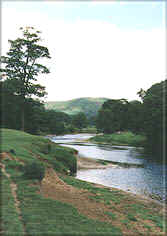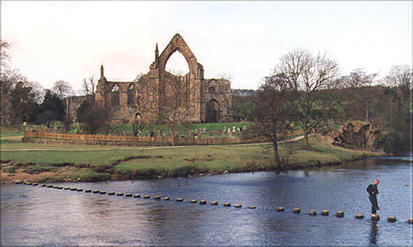Bolton Abbey
Stepping stones across the River Wharfe
Here is a view of the magnificent Bolton Priory, one of England's most beautiful ecclesiastical ruins, set in immaculate parkland. It may well be the most frequented place in Yorkshire, a real 'honeypot' of the Dales. Thousands flock here each year to enjoy the scenery, explore the ruins and have family picnics. Many confuse the name with Bolton Abbey, which is the name of the local village. The priory was used by Augustinian monks. This order was founded by St. Augustine of Hippo (354-430) in what is now Algeria, in the late 11th century. They wore a black cassock without a hood and a white surplice. They were also known as Black Canons. The original foundation was at nearby Embsay. It was Cecilia de Romille's daughter, Alice, who granted the canons this land at Bolton in 1155. The priory was dissolved in January 1539.
The nave of the church is still used as the Parish Church. The tower at the west end of the nave was commenced by Prior Richard Moone in 1520, but was never completed. The choir, chancel and transepts are in ruins, as are the secular buildings.
The Bolton Abbey Estate, privately owned by the Duke of Devonshire and his family, has over 30 miles of footpaths and is designated an area of 'Outstanding Natural Beauty' it is now classified as Heritage Land, most of which lies in the Yorkshire Dales National Park. Refreshments may be obtained from the Cavendish Pavilion or go over the bridge turn right up Storriths where you will find Back o'th' Hill Farm with the charming 'Buffers' coffee shop, complete with miles of working model railways!

The River Wharfe between Bolton Bridge and Bolton Priory
When walking through one of the many Nature Trails an abundance of birds, plants and woodland can be seen. The 'Valley of Desolation' is aptly named. The devastation was made by terrible thunderstorms over 150 years ago, an impressive waterfall is here. Extreme care must be used when walking near 'The Strid' which has claimed many lives over the years. It is here where the broad Wharfe is funnelled into a narrow channel. The sides have been undercut to a depth of 30 feet (9 metres.) The usually gentle river is turned into vicious white swirling waters. Many foolhardy folk have attempted to jump across the deceptively narrow stones and failed, then sucked into the underwater whirlpools. Perhaps one of the greatest tragedies was when a honeymooning couple drowned in 1998. It is thought they may have slipped in the swollen river. Many weeks passed before their bodies were recovered.
THE WHITE DOE OF RYLSTONEWilliam Wordsworth wrote the poem based upon this legend after a tour in that beautiful country that surrounds Bolton Priory in 1807. Francis, youngest member of the house of Norton in the early C16th, has a gentle sister, Emily to whom he gives a shy young doe, milk-white in colour, from the moors near their home. Family loyalty takes Francis with his father and brothers to join a rebellion against his will and despite his premonition of doom. The rebels are defeated and condemned to death. Only Francis is pardoned and he, returning to Norton Tower, is murdered. Emily, coming upon the loyal tenants taking him for burial, sinks down in despair. Out of the forest comes a herd of deer. One of them stops, and lays its head on Emily’s lap. It is the white doe, and it becomes Emily’s constant companion and comfort in her humble home in Rylstone, even following her down the valley of Bolton Priory to visit Francis’ grave. After Emily dies the doe faithfully continues to make the journey, and lies upon the grassy mound under which Emily’s brother lies.
BARDEN TOWER

Barden Tower
If you're a double glazing agent you may wish to call on the owners of Barden Tower. This is an historic site on the road from Bolton Abbey to Burnsall. Henry Clifford fortified and extended an old hunting lodge above Barden Bridge to make the tower and chapel after his father's attainer was reversed by Henry Tudor in 1485 and he came into full possession of his inheritance. Lady Anne Clifford claimed the tower, and restored it in 1658. The masons built well. Although it is in ruins it can still be viewed from the outside. The tower is impressive. Barden Bridge is just to the north of the tower. The tower itself was occupied into this century by a local family. You can also eat and drink here.

Barden Tower from the road.
Bill Potts, an octogenarian, living near Orlando, Florida, U.S.A. has wonderful recollections of Bolton Abbey and the area. As a teenager, in the nineteen-thirties, he used travel the area on his second-hand Norton motorcycle. His mother was doing nursing duties at a recovery centre. Bill was attending school in the U.K. and he loved his Norton, a real joy! It gave him freedom to explore the Dales that he'd never experienced before. He only parted company with his beloved machine because he was 'very fond' of a lovely English girl who disliked the pillion seat! He swapped it for a Morgan three-wheeler. What plans the young couple had were changed forever by a man named Hitler. Such sweet memories Bill.
